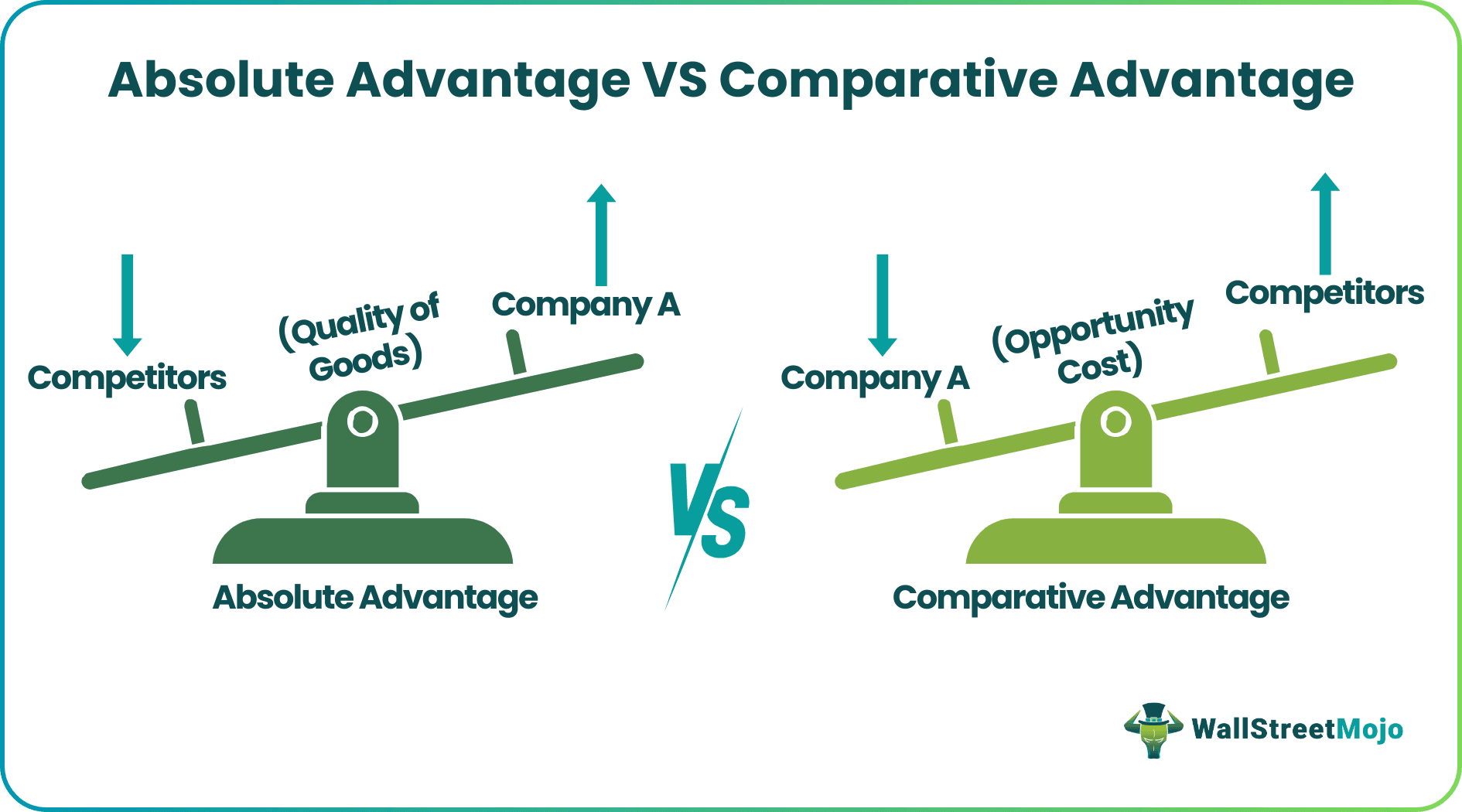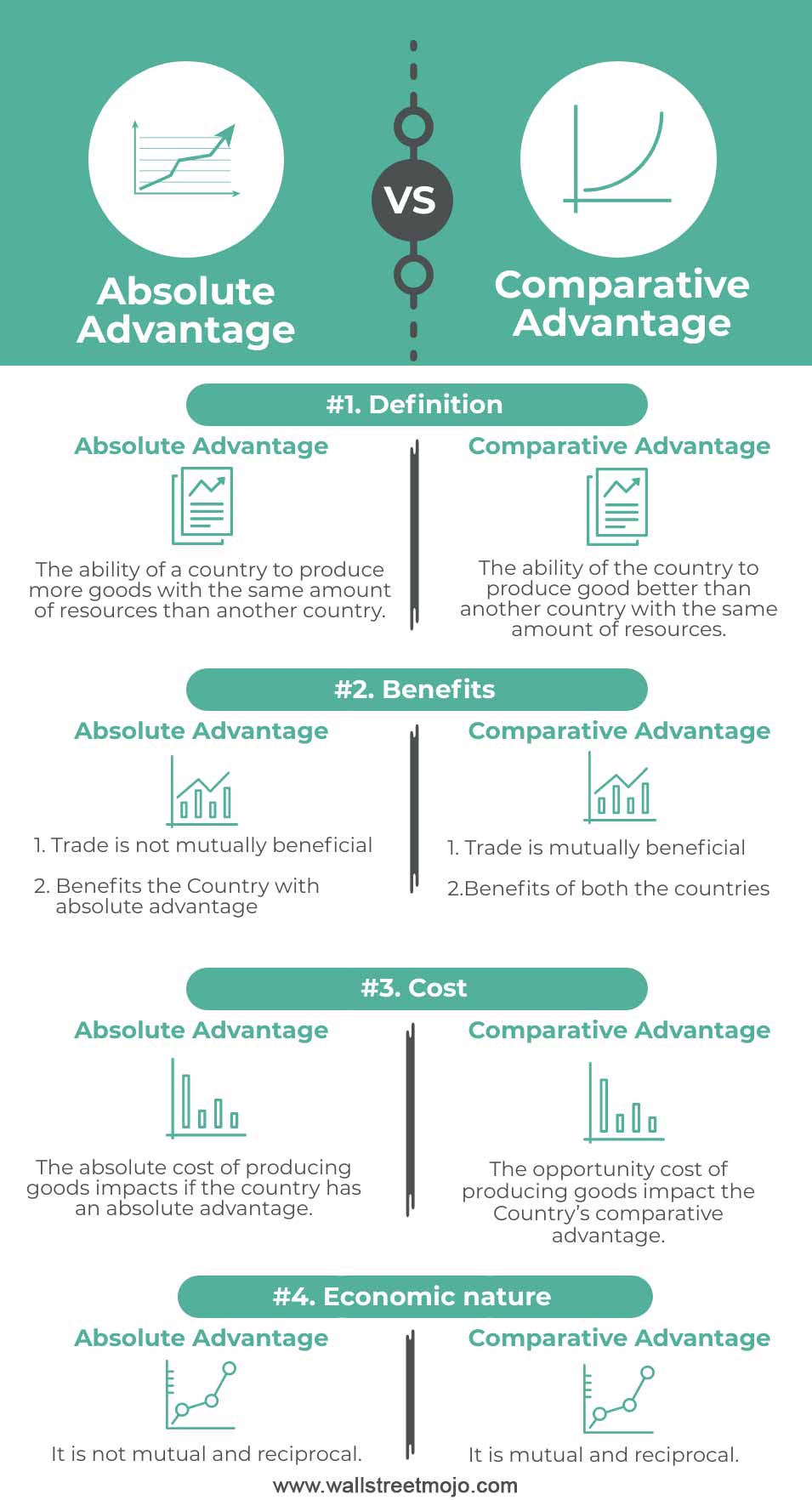Following are the differences between Absolute Vs Comparative Advantage Comparative Table
Table Of Contents

Get in Touch with our Experts!
What Is Absolute Advantage Vs Comparative Advantage?
Absolute advantage is the ability to produce an increased number of goods and services at better quality than competitors. In contrast, Comparative Advantage signifies the ability to manufacture goods or services at a relatively lower opportunity cost.

In International trade, absolute advantage and comparative advantage are widely used terms. These advantages influence the decisions taken by the countries to devout their natural resources and produce specific goods.
Absolute Advantage Vs Comparative Advantage Explained
Absolute advantage is when one country produces better quality goods at lower cost than another, whereas comparative advantage is when one country is able to produce goods at a lesser opportunity cost than the other.
It should be understood that while the theoretical differences between absolute and comparative advantage are easy to understand but practically, it is more complex. No nation has an advantage in the production of each good. Also, no country has exclusive overproduction of goods. Many factors drive the manufacturing and production of goods, making certain goods more efficient in some nations. A nation can produce some goods efficiently but may not transport and market them in other countries. Hence, these both could be better understood when countries have equal resources.
Absolute Advantage
Absolute advantage is when a country can produce particular goods at a lower cost than another country.
Few examples are:
- It is easier to extract oil in Saudi Arabia than in any other country. The abundance of oil in Saudi Arabia makes it easier as if it's only drilling an oil whereas for other countries it involves exploration and drilling cost.
- Colombia has the climatic advantage of producing coffee. Thus, it can produce coffee at a lower cost than other countries
Comparative Advantage
Comparative advantage is based on the opportunity cost of producing a good. Suppose a Country can produce a particular good at a lower opportunity cost (by losing an opportunity to produce other goods) than any other country. In that case, it is said to have a comparative advantage.
Few examples of comparative advantage are:
- Suppose the US and Japan can produce wheat or rice but not both. The US could produce 30 units of wheat or ten units of rice, and Japan could produce 15 units of wheat or 30 units. Thus, the opportunity cost of wheat is three units of wheat for 1 unit of rice for the US, whereas 0.5 units of wheat for each unit of rice for Japan. Thus, Japan has a comparative advantage in rice production since it has a lower opportunity cost.
Absolute Advantage vs Comparative Advantage Infographics
Let’s see the top absolute advantage vs comparative advantage economics.

Key Differences
- A country has an absolute advantage if it produces a large number of goods with the same resources as provided to another country whereas the country has a comparative advantage if the Country can produce a particular product with better quality at a lower price than another country.
- There is no mutual benefit in absolute trade-in advantage whereas the trade is mutually benefited with comparative advantage. The country with a higher opportunity cost of producing a good can receive it at a lower cost from the production of another country.
- Cost is a factor to determine if the country has an absolute advantage whereas opportunity cost is a factor that determines if the country has a comparative advantage.
- Comparative advantage is mutual and reciprocal whereas absolute advantage is not.
Example
Some absolute advantage vs comparative advantage example will help in understanding the concept.
Consider two countries, A and B, which have the following dynamics for the production of Maize and Corn. The output for an equal number of resources per day is as below:
| Maize | Corn | |
|---|---|---|
| Country A | 30 | 15 |
| Country B | 5 | 10 |
- For Country A, the opportunity cost of producing 15 units of Corn is 30 units of Maize, or we can say Country A has an opportunity cost of producing 1 unit of Corn to 2 units of Maize. Similarly, country B has the opportunity cost of producing 1 unit of Corn to 0.5 units of Maize. Since the opportunity cost of producing Corn in country B is less, it has a comparative advantage.
- Similarly, Country A has an opportunity cost of 0.5 units of Corn to produce 1 unit of Maize, and country B has an opportunity cost of 2 units of Corn to produce 1 unit of Maize. Thus, country A has a comparative advantage over Country B in the production of Maize. However, it has an absolute advantage since Country A can produce both Corn and Maize higher than Country B.
- Thus, if Country A produces and trades Maize while country B produces and trades Corn, both the countries will benefit from the trade with lower opportunity costs and higher efficiency.
- In the above absolute advantage vs comparative advantage example, we have seen that even if A has an absolute advantage in producing all the goods, a different country can have a different comparative advantage. Comparative advantage helps the countries decide which goods they should produce and drive the trade. Comparative advantage drives specialization in producing goods in a country as they have a lower opportunity cost and thus lead to higher production and better efficiency.
Absolute Vs Comparative Advantage Comparative Table
| Basis | Absolute Advantage | Comparative Advantage |
|---|---|---|
| 1. Definition | The ability of a country to produce more goods with the same amount of resources than another country | The ability of the country to produce goods better than another country with the same amount of resources |
| 2. Benefits | 1. Trade is not mutually beneficial | 1. Trade is mutually beneficial |
| 3. Cost | The absolute cost of producing goods impacts if the country has an absolute advantage | The opportunity cost of producing goods impact the Country’s comparative advantage |
| 4. Economic Nature | It is not mutual and reciprocal | It is mutual and reciprocal |

